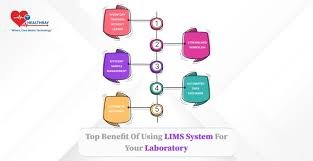Pathology labs are at the forefront of medical diagnostics, and their ability to manage vast amounts of data efficiently is crucial for ensuring accurate and timely results. With increasing volumes of patient samples, complex testing protocols, and stringent regulatory requirements, traditional methods of data management often fall short. Laboratory Information Management Systems (LIMS) have become essential tools for optimizing data management in pathology labs, offering a wide range of benefits from enhancing data accuracy to ensuring compliance.
In this article, we will explore how LIMS software can optimize data management in pathology labs, leading to greater efficiency, reduced errors, and improved patient care.
What is LIMS Software?
A Laboratory Information Management System (LIMS) is a software solution designed to manage and automate laboratory workflows, including sample tracking, data entry, result reporting, and compliance monitoring. LIMS integrates all aspects of laboratory data management into a single platform, providing real-time access to critical information and enabling labs to streamline operations.
Key Benefits of LIMS for Optimizing Data Management in Pathology Labs
1. Centralized Data Repository
One of the most significant advantages of LIMS is its ability to centralize data management. Instead of relying on paper records, spreadsheets, or disparate systems, LIMS provides a unified platform where all sample data, test results, and patient information are stored securely and accessible in real-time.
- Example: When a sample is received, LIMS logs the patient information, sample details, and tests required. All subsequent data, such as test results and analysis reports, are automatically linked to the same sample record, creating a comprehensive, searchable history.
Key Benefit: Centralized data ensures that all laboratory data is easily accessible and organized, improving workflow efficiency and reducing the risk of errors or data loss.
2. Enhanced Data Accuracy and Integrity
Manual data entry is one of the leading causes of errors in laboratory data management. LIMS reduces these risks by automating data entry, integrating directly with laboratory instruments, and performing automatic data validation checks. As a result, test results are automatically transferred from the instruments to the LIMS system, eliminating the need for manual transcription and the associated errors.
- Example: In a blood test, the analyzer automatically uploads the test results to LIMS, where they are validated against predefined criteria for accuracy. If any results fall outside acceptable ranges, the system flags them for review.
Key Benefit: Automation and integration with laboratory instruments ensure higher data accuracy and consistency, reducing the chances of human error and increasing data integrity.
3. Real-Time Access to Data
Real-time data access is essential for effective decision-making in a pathology lab. LIMS provides laboratory staff, technicians, and physicians with instant access to up-to-date information on sample status, test results, and patient data from any device, anywhere.
- Example: A pathologist can access the LIMS system to view the status of a particular test, retrieve results from previous tests, or consult patient information, all in real-time. This enables faster and more informed decision-making.
Key Benefit: Real-time data access enhances communication and collaboration, allowing healthcare professionals to make quicker, more accurate decisions and improving patient outcomes.
4. Efficient Sample Tracking and Management
Pathology labs handle numerous samples every day, and managing these samples manually can lead to delays, errors, or sample misidentification. LIMS automates sample tracking by assigning unique identifiers (such as barcodes or RFID tags) to each sample, enabling precise tracking from collection to final report.
- Example: When a sample arrives at the lab, the technician scans its barcode into the LIMS system. As the sample moves through various testing stages, the system continuously updates its location, test status, and associated data.
Key Benefit: Efficient sample tracking reduces the risk of lost or misidentified samples, streamlining lab operations and ensuring that all samples are tested promptly and accurately.
5. Improved Workflow Automation
LIMS optimizes laboratory workflows by automating tasks such as sample registration, test assignments, and result reporting. This minimizes the need for manual intervention, speeds up processes, and ensures that tests are assigned to the appropriate instruments and personnel based on predefined protocols.
- Example: Once a sample is logged into the system, LIMS automatically assigns the necessary tests and routes the sample to the appropriate testing station based on availability and priority.
Key Benefit: Automation streamlines workflows, reduces bottlenecks, and increases overall laboratory throughput, allowing more samples to be processed in less time.
6. Data Security and Compliance
Pathology labs must comply with a variety of regulations, such as HIPAA (Health Insurance Portability and Accountability Act) and CLIA (Clinical Laboratory Improvement Amendments), which require secure handling of patient data and accurate record-keeping. LIMS ensures that patient data is stored securely, with built-in access controls and encryption to prevent unauthorized access. It also helps automate compliance reporting, ensuring that the lab meets all regulatory requirements.
- Example: LIMS automatically maintains audit trails, logging all changes made to patient data and test results. This ensures that the lab can quickly provide documentation for compliance audits.
Key Benefit: LIMS helps labs meet regulatory requirements, ensuring that data is secure and accessible only to authorized personnel while reducing the risk of non-compliance penalties.
7. Enhanced Reporting and Analytics
LIMS offers advanced reporting tools that allow labs to generate customized reports on a variety of key metrics, including sample volumes, turnaround times, test accuracy, and operational performance. These reports help laboratory managers monitor performance, identify trends, and make data-driven decisions to improve efficiency.
- Example: A lab manager can generate a weekly report that tracks test completion times and error rates, helping to identify areas where additional resources or process improvements are needed.
Key Benefit: Reporting and analytics provide valuable insights into lab performance, enabling labs to make informed decisions and continuously improve their processes.
8. Seamless Integration with Other Systems
LIMS integrates seamlessly with other healthcare systems, such as Electronic Health Records (EHR), Hospital Information Systems (HIS), and other laboratory software, ensuring smooth data exchange between departments. This integration allows for better coordination of patient care and ensures that laboratory results are available to healthcare providers in real time.
- Example: Test results entered into LIMS are automatically sent to the patient’s EHR, allowing the physician to access the results without delay.
Key Benefit: Integration with other systems enhances collaboration between lab technicians, physicians, and other healthcare providers, improving the overall quality of patient care.
Key Takeaways
- Centralized data in LIMS ensures that all laboratory information is organized, accessible, and secure, improving workflow efficiency.
- Automated data entry and integration with lab instruments reduce human errors, enhancing data accuracy and consistency.
- Real-time access to data enables faster decision-making, improving patient outcomes and accelerating diagnostic processes.
- Efficient sample tracking ensures that samples are properly managed and tested, reducing the risk of misidentification and delays.
- Automation of workflows streamlines laboratory operations, increasing throughput and reducing processing time.
- Data security and compliance features help pathology labs adhere to industry regulations, ensuring the protection of patient data.
- Advanced reporting and analytics provide valuable insights into lab performance, supporting continuous improvement.
- Seamless integration with other healthcare systems ensures smooth data flow and better coordination of patient care.
Conclusion
LIMS software is an indispensable tool for optimizing data management in pathology labs. By centralizing data, automating routine tasks, improving sample tracking, and ensuring compliance, LIMS enhances the efficiency, accuracy, and security of laboratory operations. As pathology labs continue to grow in size and complexity, adopting a robust LIMS solution is critical for maintaining high-quality standards, improving patient care, and meeting regulatory requirements. With its ability to streamline operations and provide real-time insights, LIMS is essential for any pathology lab looking to stay competitive and deliver reliable, timely results.




